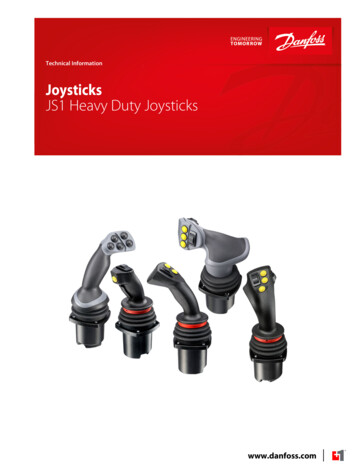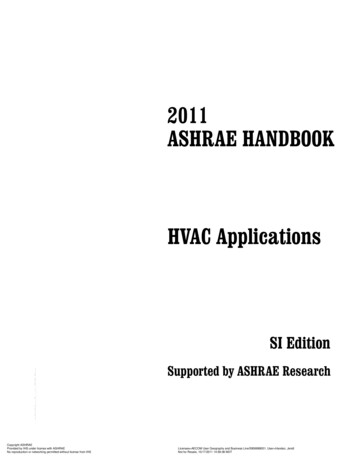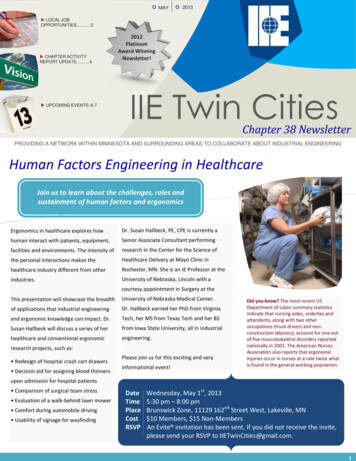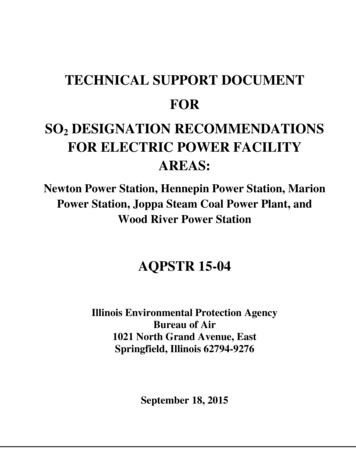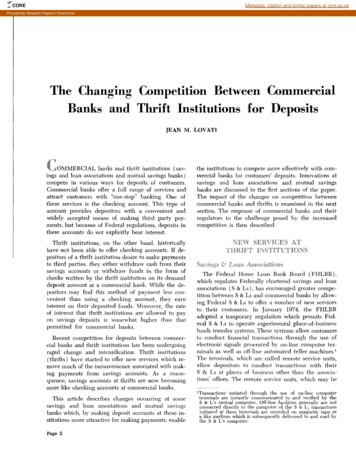
Transcription
Proceedings of the International Conference on Industrial Engineering and Operations Management Dubai,UAE, March 10-12, 2020An Ergonomic Approach on Facilities and WorkstationDesign of Public School Canteen in the PhilippinesMa. Janice J. Gumasing, Eidref Joseph E. EspejoSchool of Industrial Engineering and Engineering ManagementMapua Universitymjjgumasing@mapua.edu.ph, ejeespejo@mymail.mapua.edu.phAbstractThis paper aims to redesign the facilities and workstations of public school canteen in the Philippines by applying theprinciples of Ergonomics. Previous studies have proven that workers in the canteen are exposed to musculoskeletaldisorders and injuries due poor facility layout and workstation design. Review of related literature states that improperarrangement of tables and seats cause congestion and irrational spacing (Ismael, 2011), poor design of physicalenvironment such as ventilation, lighting and noise can cause discomfort, annoyance and dissatisfaction (Niu, et al.,2011), and improper design of workstation wherein repetitive work activities are performed lead to muscle fatigue andstress (Sripaiboonkij & Taptakarnporn, 2014). Thus, the researchers aim to assess the current condition of the publicschool canteen in the Philippines in order to determine the risk and exposure of the workers to musculoskeletaldisorders (MSD) and injuries. The researchers also aim to identify significant factors in the design of canteen thataffect the discomfort level of workers in terms of the following: personal factor, physical factors and task-relatedfactor. Key findings from the study revealed that workers in the canteen experience pain and discomfort in the neck,upper back, shoulder, lower back, upper arm, hips/buttocks and lower leg. Similarly, result of rapid entire bodyassessment (REBA) and NIOSH lifting equation proved that workers are exposed to risk of MSD due to their poorworking posture and repetitive work activities. Risk factors identified in the study were further treated and analyzedusing regression analysis. The result revealed that factors such height, body-mass index, temperature, lifting posture,and work posture significantly affect the risk and exposure of workers to MSD. Given these conditions, the researcherswere able to redesign the facilities and workstation of public school canteen by applying the principles of ergonomics,quality function deployment (QFD) and systematic layout planning (SLP) tools.Keywordsergonomic design, facilities design, workstation design, canteen, public schoolI. IntroductionThe school canteen is a great place to promote an enjoyment of healthy eating. For students who use the canteenregularly, the food purchased makes a significant contribution to their total food intake and nutrition; therefore it makessense to ensure the best food possible is available to enhance their ability to learn and take in the information presentedto them in class. However, when running a school canteen, schools can face a number of problems that stop them fromgetting the most out of their service. One of the biggest problems that school canteen experience especially in thepublic schools is the lack of space and poor layout design. School canteen especially the kitchen area have usuallyconfined space and force workers to stand for a long period of time in almost static motions, causing pain anddiscomfort.Previous studies and researchers have revealed that workers in school canteen are exposed to risk of occupationalinjuries and musculoskeletal disorders. The study of Niu, et al. (2011) showed that staffs in school canteen suffer fromlong working hours and over loads on hands. They are exposed to improper postures like awkward bending and manuallifting. Canteen workers are also exposed to occupational injuries due to working in high surfaces and poor workstationdesign. Workers experience pain and discomfort in the shoulders and upper limbs due to raised position of arms duringwork posture (Pekkarinen, Anttonen & Niskanen, 2015). Repetitive work activities such as cutting, grinding and IEOM Society International1662
Proceedings of the International Conference on Industrial Engineering and Operations Management Dubai,UAE, March 10-12, 2020washing can also lead to muscle fatigue and stress. Because of these, workers experience pain and discomfort in theirwrist, hands and shoulders (Sripaiboonkji & Taptakarnporn, 2014).In all kinds of work, workload and inappropriate posture may expose employees to injuries and musculoskeletaldisorders (Szabo, 2004). Risk factors that may contribute to work musculoskeletal disorders and discomfort mayinclude awkward posture, material handling, repetition, force, mechanical compression, vibration, temperatureextremes, glare, inadequate lighting, and duration of exposure (Gumasing & Pacheco, 2018; Gumasing & Sasot, 2019).Therefore, employees who spend many hours at a workstation may develop ergonomic-related problems resulting inmusculoskeletal disorders.For this reason, it is important that ergonomics be considered. Ergonomics is the study of people working efficientlyinside a workspace. For canteen kitchens, that means having both an ergonomic space itself, good layout design andproper design of physical environment. Ergonomics is a science of fitting workplace conditions and job demands tothe capability of the working population. The goal of ergonomics is to reduce stress and eliminate injuries and disordersassociated with the overuse of muscles, poor posture and repetitive task.Although there are numerous researchers that were done to assess and evaluate the facility and workstation design ofcanteen, however, only limited amount of research had focused on the area of public school canteen. Layout design ofpublic school canteens are very much different from private school given the fact that public schools are morepopulated than private schools that is why workers in the public schools are more exposed to longer working hours.In addition, facilities and resources are usually much better in private schools. Given these conditions, the researchersaim to conduct a study on the facilities and workstation design of public school canteen in the Philippines by applyingthe principles of ergonomics in order to reduce the risk of workers from musculoskeletal disorders and injuries.2. MethodologyThe researchers conducted the study among the six (6) public schools in Metro Manila wherein large numbers ofstudents and staff were located. A total of 42 respondents were involved in the study. The researchers have conductedreview of related literature, direct observation, surveys, interview and actual measurement of tools and materials usedby canteen staff. Devices such as BP meter, light meter, noise dosimeter, and digital psychrometer were used to obtaindemographic profile factors of the respondents as well as measures for environmental factors. The researchers alsoused Cornell Musculoskeletal Disorder Questionnaire (CMDQ) in order to determine the discomfort location andcommon types of musculoskeletal disorders experienced by canteen staff when performing their tasks. Posturalanalysis was also done in order to gather data for task related factors. The researchers used Rapid Entire BodyAssessment (REBA) to evaluate whole body postural MSD and measure risks associated with the task of canteen staff.NIOSH lifting equation was also used to assess the manual material handling risks of workers associated with liftingand lowering tasks in their job.2.1 Statistical AnalysisDescriptive measures were used to provide an analysis of summary of factors obtained from data gathering. Thishelped the researches to come up with analysis and draw appropriate conclusions without bias. Collected data fromsurvey, interview and observations were arranged in a manner of which the data can be easily interpreted through theuse of frequency count and percentage distribution. In addition, the factors considered in the study were statisticallytreated and analyzed using correlation analysis and regression method. The researchers also used Quality FunctionDeployment (QFD) tool to transform the customer’s demands into the technical requirements of the workstationdesign. The researchers also applied ergonomics principles such as anthropometry in order to identify the physicaldimensions of the proposed design. The researcher needs to match all these considerations and come up with aproposed workstation. For the design of facilities, systematic layout planning (SLP) was used to arrange the workplacein a layout by locating areas with high frequency and logical relationships close to each other. This process permitsthe quickest material flow in performing the task. IEOM Society International1663
Proceedings of the International Conference on Industrial Engineering and Operations Management Dubai,UAE, March 10-12, 20203. Result and Discussion3.1 Result of Postural AnalysisThe figure below showed the overall summary of results of the CMDQ from the 42 respondents of the study andranked from highest to lowest percentage of risk.% OF re 1. Result of CMDQ ScoresBased on the results, the most affected body parts of workers in terms of discomfort and MSD when performing theirtasks are the following: neck, upper back, shoulders, lower back, hips/buttocks, upper arm and lower leg.In order to validate the cause of discomfort and MSD of workers, the researchers conducted rapid entire bodyassessment (REBA) as shown in figures below.DishwasherCook2. Work Posture of Canteen StaffCashier FigureTable 1. Summary of REBA ScoresTasksScore AScore BScore AScore9810Remarkshigh riskhigh riskhigh risk IEOM Society International1664
Proceedings of the International Conference on Industrial Engineering and Operations Management Dubai,UAE, March 10-12, 2020The result of REBA scores indicated that the current work posture of workers dishwashing, cook and cashier pose highrisk of developing a range of disorders primarily to upper limb and lower back associated with the occupational taskand must be investigated and change immediately.Table 2. Summary of NIOSH ScoresThe researchers also assessed the lifting posture of canteen staff using NIOSH Lifting Equation. The job resulted inpoor lifting conditions specifically on the task of lifting of water from the floor. This caused for concern as the locationof the hands of the workers when lifting is outside the preferred lifting zone of 75 cm to 110 cm vertical height andhorizontal reach of 40 cm based from 5th percentile female reach distance with elbow at side of body (Pheasant &Haslegrave, 2006). This proved why majority of the workers experienced pain and MSDs on their parts of the body asreflected in the CMDQ scores of the respondents. The result of NIOSH lifting equation is shown in the table above.3.2 Assessment of Physical EnvironmentThe researchers also assessed the physical work condition of public school canteen in terms of temperature level,illumination level and noise level. The result of physical assessment is shown on the table below.Table 3. Summary of Physical Environmental AssessmentPHYSICAL ENVIRONMENTTEMPERATURE (in Celsius)SCHOOLLIGHTING (in lux)NOISE LEVEL (in db)Llano HENAREA78.58DININGAREA75.3KITCHENAREA72.1Caybiga ES33.433.439.8239.8377.877.8Deparo ES303172.1274.2769.569.4Caybiga HS33.931.348.4480.7380.177.4Deparo HS33.13054.982.8861.370.9Bagbaguin UREMENTREMARKSTemperature (in ion (in lux)at riskat riskKitchenDining66.9261.17at riskat riskKitchen72.75500150-200Noise (in dB)90no risk IEOM Society International1665
Proceedings of the International Conference on Industrial Engineering and Operations Management Dubai,UAE, March 10-12, 2020Dining72.5290no riskThe results of the assessment on the physical environment indicated that temperature level and illumination level ofboth kitchen and dining area pose risk for the occupants since they are beyond the recommended and ideal level basedon the standards set by American National Standards Institute (ANSI).3.3 Result of Statistical AnalysisAll the data gathered from the initial assessment were further analyzed and treated using statistical analysis. Regressionanalysis was used to verify true predictors for discomfort and MSD experienced by workers in the public schoolcanteen. The factors considered in the study are based from review of related literature, observation, interview andsurvey. Major factors and sub-factors were considered in the study as follows: (1) personal factor: age, gender, height,weight, BMI, (2) environmental factor: temperature, illumination, noise, (3) task-related factors: rest period, workduration, work posture and lifting posture. The result of the regression equation is shown below.CMDQ Score -21.82 0.609 Height 0.1525 BMI 3.321 Temperature 2.436 REBA 1.876 NIOSHThe result showed that factors that have significant effect to the MSD experienced by canteen workers are height,BMI, temperature, work posture and lifting posture. The model summary for the regression model incurred an adjustedR2 of 87.62% with coefficient correlation (R) values of 0.912, which explained that independent variables in theequation are strong predictors for the musculoskeletal disorders of public school canteen workers. This served as thefocus of the researchers in the development of risk mitigation plan. In addition, the researchers validated if the valuesused in the analysis are normally distributed even after eliminating all the outliers. The figures below showed that theresiduals CMDQ are normally distributed and the points are randomly scattered around the line, which indicated thatthere was no violation in terms of normality, which is a requirement for multiple regression analysis.Figure 3. Results of Normality Test3.4 Workstation DesignThe results of the analyses have proven the need for the redesign of facilities and workstation for public school canteen.Therefore, the researchers used the principles of anthropometry to ensure that the design will match the bodydimensions of users in order to improve their comfort, health, safety and productivity. Below are the anthropometricdimensions for the proposed workstation design.Table 3. Recommended Anthropometric Measurements of Design Glass Cabinet for WorkersTABLE (GLASS CABINET) FOR CASHIERACTUALBODY REFERENCEthRECOMMENDEDTable height63 cmElbow height (5 % F)89 cmTable width84 cmArm span (5th % F)141 cm IEOM Society International1666
Proceedings of the International Conference on Industrial Engineering and Operations Management Dubai,UAE, March 10-12, 2020Figure 4. 3D Perspective Design of Glass CabinetTable 4. Recommended Anthropometric Measurements of Workstation Design for WorkersCOUNTER TOP FOR DISHWASHERACTUALTable heightBODY REFERENCERECOMMENDEDth72 cmElbow height (5 % F)89 cmCOUNTER TOP FOR COOKINGACTUALTable height72 cmBODY REFERENCERECOMMENDEDthElbow height (5 % F)89 cmFigure 5. 3D Perspective Design of WorkstationTable 5. Recommended Anthropometric Measurements of Chairs and Table Design for ElementaryStudentsCHAIR/STOOL WITH BACK RESTACTUALSeat heightSeat depthSeat width44 cm48 cm45 cmBack rest54 cmBODY REFERENCEthPopliteal height (5 % F)Buttock popliteal (5th% F)Hip breadth (95th % F)Shoulder height (5th % F) - poplitealheight (5th %F) - buttock poplitealdepth (5th %F)RECOMMENDED35.438.530.242.6TABLEACTUALBODY REFERENCERECOMMENDEDthTable height101 cmPopliteal height (5 % F) sittingelbow height (5th % F)53.2 IEOM Society International1667
Proceedings of the International Conference on Industrial Engineering and Operations Management Dubai,UAE, March 10-12, 2020Table 6. Recommended Anthropometric Measurements of Chairs and Table Design for HighSchool StudentsCHAIR/STOOL WITH BACK RESTACTUALBODY REFERENCERECOMMENDEDSeat heightSeat depthSeat width44 cm48 cm45 cm36 cm40 cm42.43 cmBack rest54 cmPopliteal height (5th %F)Buttock popliteal (5th %F)Hip breadth (95th %F)Shoulder height (5th %F) - poplitealheight (5th %F) - buttock poplitealdepth (5th %F)42 cmTABLETable heightACTUALBODY REFERENCERECOMMENDED101 cmPopliteal height (5th % F) sittingelbow height (5th % F)53 cmFigure 6. 3D Perspective Design of Table & Chairs3.4 Facilities DesignIn order to redesign the facilities of public school canteen in order to improve the efficiency and productivity ofworkers, the researchers used systematic layout planning. It is a tool used to arrange workplace in a facility by locatingareas with high frequency and logical relationships close to each other. And in order to determine the arrangement ofactivities in the work area in a systematic manner, the researchers developed a relationship chart and diagram for eachpublic school canteen considered in the study. The result is shown in the figures below.Figure 7. Relationship Chart and Diagram for Facility LayoutA.Facilities Design for Llano Public School IEOM Society International1668
Proceedings of the International Conference on Industrial Engineering and Operations Management Dubai,UAE, March 10-12, 2020Figure 8. Current and Proposed Layout Design of Llano Public SchoolThe proposed design of the school canteen in Llano Public School includes the following: first, to maximize the space,preparation of snacks in tray must be located on the left side of the dining area upon entry. Second, school suppliesarea (bookstore) must be relocated on the back of the dining area near the cashier for easier transaction. And finally,drinks station and water dispenser must be placed together and must be located near the cashier for easier flow oftraffic.B.Facilities Design for Caybiga Public SchoolFigure 9. Current and Proposed Layout Design of Caybiga Public SchoolThe proposed layout design for Caybiga canteen includes relocating the dining area on the center of the canteen toprovide space around the dining area. In addition, the area for drinks station, packed snacks, condiments and cashierare transferred on the back of the dining area for easier flow of traffic and avoid congestion.C.Facilities Design for Deparo Public SchoolFigure 10. Current and Proposed Layout Design of Deparo Public SchoolThe proposed layout design for Deparo canteen involves relocating the dining area on the front side of the canteenupon entry in order to have more space and accommodate more students, this layout will also permit easy flow ofstudents coming in and out of the canteen since the dining area is far from the door. It is also recommended to relocatethe drinks station, packed snacks, bookstore and cashier on the back side of the dining area for easier flow of trafficand avoid congestion. IEOM Society International1669
Proceedings of the International Conference on Industrial Engineering and Operations Management Dubai,UAE, March 10-12, 2020D.Facilities Design for Bagumbong Public SchoolFigure 11. Current and Proposed Layout Design of Bagumbong Public SchoolThe proposed layout for Bagumbong canteen is designed in such a way that the preparation area for lunch meal andpacked meal be located in the same area for easier transaction. This will also provide more space for bookstore anddrinks station. It is also recommended to transfer the bookstore and drinks station on the other side of the canteen topermit easier flow of traffic going in and out of the dining area.4. ConclusionThe findings of the study have proven that workers in canteen are exposed to risks of musculoskeletal disorders andinjuries due to poor facility and workstation design. The risk was evident on the scores generated by RULA and NIOSHcomputed from their body postures while performing tasks. Based on the result of CMDQ, majority of the respondents’experience pain on their neck, upper back, shoulders, lower back, hips/buttocks, upper arm and lower leg. Several riskfactors were considered in the study based on review of related literature, direct observation and interview from thepeople involved in the tasks. Factors considered are the following (1) personal factor: age, gender, height, weight,BMI, (2) environmental factor: temperature, illumination, noise, (3) task-related factors: rest period, work duration,work posture and lifting posture. These factors were analyzed and treated using regression analysis. The result revealedthat factors such height, body-mass index, temperature, lifting posture, and work posture significantly affect the riskand exposure of workers to MSD. Given these conditions, the researchers were able to redesign the facilities andworkstation of public school canteen by applying the principles of ergonomics, quality function deployment (QFD)and systematic layout planning (SLP) tools.ReferencesASHRAE. Thermal Environmental Conditions for Human Occupancy on American National StandardsANSI/ASHRAE 55-192.20p., 1992Benya, J. Lighting for Schools. National Clearinghouse for Educational Facilities (NCEF). Available:http://www.ncef.org/pubs/lighting.pdf, 2001Boland, M. School types: The difference between public, private, magnet, charter, and more. Available:https://www.babycenter.com/0 -magnet-ch 67288.bc, 2016.Core, Jr. Case Study:Greater Good Studio on Designing Everything but Food, Part 1. but-theFoodPart-1, April 15, 2013El-Said, O., & Fathy, E. A. Assessing university students' satisfaction with on-campus cafeteria services, TourismManagement Perspectives, 2015Gumasing, M.J.J., & Pacheco, E.G. P., (2018). Predictive Model on the Severity of Musculoskeletal Disorder andAccidents of Truck Drivers in the Philippines. 2018 2 nd European Conference on Industrial Engineering andOperations Management (IEOM), Paris, France, July 26-28, 2018 IEOM Society International1670
Proceedings of the International Conference on Industrial Engineering and Operations Management Dubai,UAE, March 10-12, 2020Gumasing, M. J. J., & Sasot, Z. B. (2019). An Occupational Risk Analysis of Garbage Collection Tasks in thePhilippines. 2019 IEEE 6th International Conference on Industrial Engineering and Applications (ICIEA). doi:10.1109/iea.2019.8715109Hoe, Y. The HKU Scholars Hub. Available: t.pdf?accept 1, 1995Hood, N. Availability of Drinking Water in US Public School Cafeterias. Journal of the Academy of Nutrition andDietetics, doi: 10.1016/j.jand.2014.02.001. Apr 9, 2014.IDEO. A cafeteria designed for me. Available: me/, 2013Ito, T. A Simulation-Based Approach to Congestion Problem in Cafeteria. First Asia International Conference onModelling & Simulation, 2007.MarlaReicks. (2014). Impact of Cooking and Home Food Preparation Interventions Among Adults: Outcomes andImplications for Future Programs. Journal of Nutrition Education and Behavior, doi: 10.1016/j.jneb.2014.02.001.April 1, 2014Niu, J., Zheng, X., Zhang, L., Xu, S. Y., Li, X., Guo, S. S., & Ding, S. Investigation of ergonomics in Chineseuniversity cafeterias' working situation at peak hours using jack. IEEE 18th International Conference on IndustrialEngineering and Applications, 2011.Ostrom, L., Romero, H., Gilbert, B., & Wilhelmsen, C. (1993). Ergonomic assessments of three Idaho NationalEngineering Laboratory cafeterias. Energy Technology Data Exchange (ETDEWEB), 1993.Pehkonen, I. (2009). Evaluation of a participatory ergonomic intervention process in kitchen work. AppliedErgonomics. doi: 10.1016/j.apergo.2008.01.006. March 7, 2008.Pekkarinen, & Anttonen. The effect of working height on the loading of the muscular and skeletal systems in thekitchens of workplace canteens. Applied Ergonomics. doi: ber 1988.Pekkarinen, Anttonen, & Niskanen. (2015). Assessment of Health Risks in Canteen Kitchens. International Journalof Occupational Safety and Ergonomics. doi: https://doi.org/10.1080/10803548.1996.11076354, January 8, 2015Shamrao, Malhari, Kumar, Kulkarni, James, & Naikpawar. A Study of Facilities Given By Canteen In College-SpecialReference to Pradhikaran, 2015Sripaiboonkij, P., & Taptakarnporn, S. Health Effects on Canteen Staff Working in a University Canteen. Journal onHealth, October 2014Yong Jeong, B. Cooking processes and occupational accidents in commercial restaurant kitchens. Safety ScienceJournal, doi: 10.1016/j.ssci.2015.07.014, December 2015BiographiesMa. Janice J. Gumasing is a Professor of School of Industrial Engineering and Engineering Management at MapuaUniversity, Philippines. She has earned her B.S. degree in Industrial Engineering and Masters of Engineering degreefrom Mapua University. She is a Professional Industrial Engineer (PIE) with over 15 years of experience. She is alsoa professional consultant of Kaizen Management Systems, Inc. She has taught courses in Ergonomics and HumanFactors, Cognitive Engineering, Methods Engineering, Occupational Safety and Health and Lean Manufacturing. Shehas numerous international research publications in Human Factors and Ergonomics.Eidref Joseph E. Espejo graduated from Mapua University with B.S. degree in Industrial Engineering. He is amember of Philippine Institute of Industrial Engineers (PIIE) Mapua Chapter and also an active member in OperationResearch Society of the Philippines (ORSP) Mapua Chapter. His research interest includes Risk Management,Ergonomics and Human Factors. IEOM Society International1671
Layout design of public school canteens are very much different from private school given the fact that public schools are more populated than private schools that is why workers in the public schools are more exposed to longer working hours. In addition, facilities and

